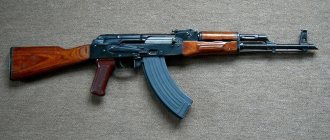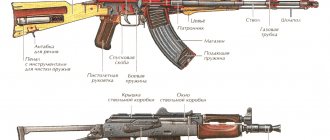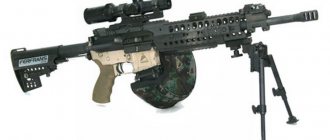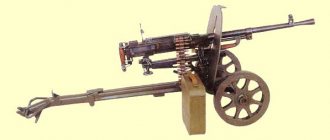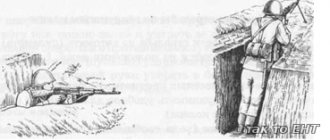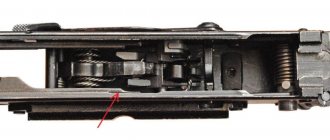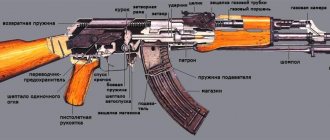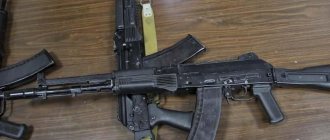The experimental AK-46 assault rifle was designed in 1946. The weapon was created as the best option for using the 1943 model military cartridge. The main detail in the new design was an updated system designed for a charge with intermediate power. This solution was prepared by many countries, but was first implemented in Germany. Such a cartridge created significantly less pressure in the barrel than its rifle counterpart. Let's look at the features of an experienced weapon.
Peculiarities
The domestic development of a cartridge for the AK-46 assault rifle cannot be called a direct copy of similar shells, as some believed. The intermediate type ammunition was developed taking into account domestic requirements and characteristics. As it soon became clear, the new cartridge could not one hundred percent solve the problem of versatility in terms of accuracy of hitting the target and effective firing range.
The resulting element did not meet the necessary requirements, corresponding to an accuracy range of no more than 300 meters with the ability to penetrate a steel helmet from 50 meters (the cartridge for the TT pistol had similar parameters). It was necessary to come up with a weapon that could hit targets at a distance of up to 800 meters in single salvoes and 400-500 meters in bursts. As a result, a 7.62 mm caliber cartridge, developed by several designers in 1943, was adopted.
Race without favorites
As for the “automatic” competition, then hardly anyone would have undertaken to predict its winner. Automatic rifles chambered for an intermediate cartridge were a new type of weapon, and already the first stage, carried out in 1944, showed that the enormous design experience of the older generation of Soviet gunsmiths - Tokarev, Simonov, Degtyarev, Shpagin - did not give them any special advantages. Of course, they still had every chance to make it big, but young, unknown developers had no less chances.
7.62-mm experimental Korovin assault rifle, model 1946
As the previous time, the Kovrov residents showed great activity. From the “Degtyarevsky” KB-2 and the factory design bureau, nine projects took part in the draft part of the competition, and in total 16 of them were provided to the State Autonomous Agrarian University. Of the weapons “stars” of the first magnitude, in addition to Degtyarev, S.G. took part in the competition. Simonov, but other competitors were also very eminent: for example, S.V. Vladimirov has already become the author of his own heavy machine gun, and the experienced submachine gun I.K. Bezruchko-Vysotsky in 1942 had a significant influence on the design of the future teaching staff.
As a result, the opinion of the competition commission was as follows: the first prize was not given to anyone, the 2nd prize was given to N.V.’s project. Rukavishnikov, 3rd prize - project by G.A. Korobova. Honorable mentions were given to M.T. Kalashnikov, A.A. Bulkin, A.A. Dementyev, K.A. Baryshev, I.K. Bezruchko-Vysotsky.
Korobov assault rifle
If we talk about originality, then, most likely, Korobov could fully count on the first prize. It is unlikely that the USSR at that moment knew about the British developments of bullpups, which soon ended with the creation of the EM-2 rifle. But we can say for sure that Korobov made a Soviet bullpup or, as they wrote then, a “short machine gun” - a weapon in which the magazine receiver window was located behind the fire control handle.
As for the N.V. machine gun. Rukavishnikov, then his machine gun showed the best results when shooting single shots. True, when firing in bursts, like all other machine guns, it was inferior to the PP-41. In addition, Rukavishnikov was unable to stay within the weight specifications - his version with a permanent wooden stock and an attached magazine tipped the scales at 4.65 kg. The excess of 150 grams, of course, could be forgiven - Rukavishnikov’s design had reserves for weight reduction, for example, in the form of a holding handle on the forend. However, based on the test results, a number of other complaints emerged, for example, about the design complexity of individual parts or large width dimensions.
Variants of the Rukavishnikov assault rifle with a wooden butt (above) and a steel folding one (below)
Dementyev's assault rifles turned out to be the lightest of those presented at the competition - 4.04 and 4.14 kg for the version with a steel folding stock and a permanent wooden one, respectively. In addition, the Kovrov assault rifle turned out to be one of the most reliable when firing without failure, both in various conditions and with a large number of shots. But the survivability of the AD-46 parts let us down - there were 16 breakdowns out of 14,450 rounds, which was the worst result of all. The samples from Tula A.A performed well. Bulkina. It is curious that in his machine gun they saw similarities with Sudaev’s model:
“In terms of the layout of the moving system on top of the receiver, the placement of the return mechanism and the method of fixing the box cover, the Bulkin assault rifle is similar to the Sudaev system.”
In addition, for both Bulkin and Dementiev, the commission conducting the tests issued, in particular, the following recommendation:
“To develop a more advanced design of the metal stock, ensuring that it protrudes the least beyond the dimensions of the machine gun when folded (to abandon the American M-1 design).”
And now it’s time to ask - where is Kalashnikov on this list?
Development
The main designer of the domestic model of the AK-46 assault rifle was A. I. Sudaev. In one year he managed to develop four starter kits. Other developers soon joined in working on the prototype. As a result, an automatic rifle with an intermediate cartridge was created, which ensured firing efficiency at a range of 0.5 km; the weapon itself was equipped with a magazine for three dozen rounds of ammunition. Such famous designers as Degtyarev, Korovin, Bulkin and Baryshev took part in the competition.
Initially, the leadership went to the developer of the AK-46 assault rifle, Sudaev; already in 1945, his “brainchild” underwent field tests. A year later, a number of analogues were presented. As a result, it was the Kalashnikov assault rifle that was adopted into official service by the Soviet army.
Designer Kalashnikov: AK-46 and others
The first steps towards domestic automatic weapons chambered for an intermediate cartridge were very uncertain - not only did the designers not have a clear idea of what exactly they needed to design, but also the military customers did not understand very well what they needed. In such a situation, the right solution could only be developed by trial and error.
Death makes adjustments
The Sudaev AS-44 assault rifle was a good answer to the question “what to do if the war drags on and the Wehrmacht switches to stormtroopers.” However, already at the beginning of 1945 it was quite clear that the war would not last long. Under these conditions, there was no time, nor any sense, to launch large-scale production of small arms chambered for the 1943 model cartridge, since both the RPD-44 and AS-44 at that moment were designs that required serious development.
Sudaev AS-44 assault rifle
The results of the field and military tests gave rise to new requirements of the Main Artillery Directorate of the Red Army (GAU KA). The experience of early 1944 had an impact, when in a competition for a heavy machine gun, some of the submitted samples turned out to be obvious light machine guns, far exceeding the 5 kg limit declared in the military requirements. New tactical and technical requirements No. 3131-45 have already more clearly outlined the appearance of the future machine gun:
“The machine gun should be an individual weapon designed to arm machine gunners in rifle units, in special teams of all branches of the military, instead of the PP-41 and PP-43 in service... The machine gun is intended mainly for hitting living targets at firing ranges of up to 500 m, aiming firing range - 800 m."
It was planned to increase the tactical mobility of a fighter with a machine gun by reducing the maximum weight of the weapon to 4.5 kg and reducing its length, while allowing one to forget about the bipod. Tests carried out in 1945 at the Shchurovsky training ground of the GAU KA (NIPSVMO - Scientific Research Range of Small and Mortar Weapons) showed that it was possible to shorten the barrel slightly, which would take place without compromising accuracy.
Meanwhile, it was the accuracy of the new type of weapon that did not suit the military. The AS-44 was not bad for wartime, and when fired from a bipod at medium distances it was comparable to a DP light machine gun. This fit well into the concept of a “heavy machine gun” as an “ersatz handbrake.” However, after the victorious May 1945, the military had a desire to get a weapon that could replace the infantry with both a rifle with its long-range accurate shooting capabilities, and a submachine gun that gave a high density of fire at close ranges. Accordingly, the rifle of the 1891/30 model was considered as a model for single-shot shooting, and for the automatic fire mode this became the PPSh, or PP-41, as it was designated in a number of documents.
Looking ahead, it is worth noting two interesting facts. Firstly, the automatic fire characteristics of the Shpagin submachine gun, as was established by post-war research, were quite close to optimal for an individual automatic weapon. On the other hand, the attempt to achieve them became exactly that “stone flower” that Danila the master never succeeded in achieving. But all this happened later - then, in 1945, it once again seemed to the military and designers that such a weapon could be developed using a new cartridge.
A.I. was considered the main favorite of the upcoming competition. Sudaev. His machine gun has already become a winner once, has gone through several stages of testing, and a series has been produced for military testing. Accordingly, Alexey Ivanovich could find out the advantages and disadvantages of his machine gun in order to improve it further. Indeed, in 1945, Sudaev, based on the AS-44, presented for testing a new assault rifle, which received the designation OAS - “Lightweight Sudaev Automatic.” The sample differed from previously tested versions of the AS-44 by the absence of a bipod and bayonet, a change in a number of wooden parts, and lightening of some metal parts.
However, tests of OAS have shown that simple relief, without deeper redesign of the design, does not solve the problem. Due to the reduction in mass, the accuracy, which was not entirely satisfactory to the customer, deteriorated even further. The machine had to be modified, but Sudaev was not given time for this: on August 17, 1946, the designer died in the Kremlin hospital. This was the end of the story of Sudaev’s machine guns, but not the ideas embedded in them.
Race without favorites
As for the “automatic” competition, then hardly anyone would have undertaken to predict its winner. Automatic rifles chambered for an intermediate cartridge were a new type of weapon, and already the first stage, carried out in 1944, showed that the enormous design experience of the older generation of Soviet gunsmiths - Tokarev, Simonov, Degtyarev, Shpagin - did not give them any special advantages. Of course, they still had every chance to make it big, but young, unknown developers had no less chances.
7.62-mm experimental Korovin assault rifle, model 1946
As the previous time, the Kovrov residents showed great activity. From the “Degtyarevsky” KB-2 and the factory design bureau, nine projects took part in the draft part of the competition, and in total 16 of them were provided to the State Autonomous Agrarian University. Of the weapons “stars” of the first magnitude, in addition to Degtyarev, S.G. took part in the competition. Simonov, but other competitors were also very eminent: for example, S.V. Vladimirov has already become the author of his own heavy machine gun, and the experienced submachine gun I.K. Bezruchko-Vysotsky in 1942 had a significant influence on the design of the future teaching staff.
As a result, the opinion of the competition commission was as follows: the first prize was not given to anyone, the 2nd prize was given to N.V.’s project. Rukavishnikov, 3rd prize - project by G.A. Korobova. Honorable mentions were given to M.T. Kalashnikov, A.A. Bulkin, A.A. Dementyev, K.A. Baryshev, I.K. Bezruchko-Vysotsky.
Korobov assault rifle
If we talk about originality, then, most likely, Korobov could fully count on the first prize. It is unlikely that the USSR at that moment knew about the British developments of bullpups, which soon ended with the creation of the EM-2 rifle. But we can say for sure that Korobov made a Soviet bullpup or, as they wrote then, a “short machine gun” - a weapon in which the magazine receiver window was located behind the fire control handle.
As for the N.V. machine gun. Rukavishnikov, then his machine gun showed the best results when shooting single shots. True, when firing in bursts, like all other machine guns, it was inferior to the PP-41. In addition, Rukavishnikov was unable to stay within the weight specifications - his version with a permanent wooden stock and an attached magazine tipped the scales at 4.65 kg. The excess of 150 grams, of course, could be forgiven - Rukavishnikov’s design had reserves for weight reduction, for example, in the form of a holding handle on the forend. However, based on the test results, a number of other complaints emerged, for example, about the design complexity of individual parts or large width dimensions.
Variants of the Rukavishnikov assault rifle with a wooden butt (above) and a steel folding one (below)
Dementyev's assault rifles turned out to be the lightest of those presented at the competition - 4.04 and 4.14 kg for the version with a steel folding stock and a permanent wooden one, respectively. In addition, the Kovrov assault rifle turned out to be one of the most reliable when firing without failure, both in various conditions and with a large number of shots. But the survivability of the AD-46 parts let us down - there were 16 breakdowns out of 14,450 rounds, which was the worst result of all. The samples from Tula A.A performed well. Bulkina. It is curious that in his machine gun they saw similarities with Sudaev’s model:
“In terms of the layout of the moving system on top of the receiver, the placement of the return mechanism and the method of fixing the box cover, the Bulkin assault rifle is similar to the Sudaev system.”
In addition, for both Bulkin and Dementiev, the commission conducting the tests issued, in particular, the following recommendation:
“To develop a more advanced design of the metal stock, ensuring that it protrudes the least beyond the dimensions of the machine gun when folded (to abandon the American M-1 design).”
And now it’s time to ask - where is Kalashnikov on this list?
Where is Kalashnikov?
When writing the article, the author was very tempted to insert here a quote from the author of the book about domestic machine guns A.A. Malimona that “the sergeant from the mechanical... is invisibly present.” However, at the stage of the competition, Mikhail Timofeevich was already quite visibly present, presenting his AK-46 in two versions for testing.
It should be noted that in the drawings and photos with incomplete disassembly they try to show this particular Kalashnikov sample, so to speak, in an incompletely disassembled form. The fact is that the AK-46, when disassembled, had an external resemblance... yes, to the German Sturmgewehr. In this sample, Kalashnikov made separate receiver and trigger boxes, guides and a pin. At the same time, even before the Sturmgever, both the PPS and the PPSh, and many banal hunting double-barreled guns, had a “turning point” design. To put it simply, the scheme was known a long time ago, it had both advantages - for example, easy access to the breech of the barrel - and disadvantages in the form of lower structural strength. Actually, the test site report said: “The stamped receiver is similar to the submachine guns of Sudaev and Bezruchko-Vysotsky.”
. It is interesting that from the very beginning Kalashnikov was working on a version with a milled receiver, which had quite noticeable design differences.
One of the prototypes of the Kalashnikov AK-46 assault rifle
The AK-46 performed well in tests, even then demonstrating its signature reliability in difficult conditions, beating all other competitors at this stage, but not everything was so smooth:
“In the original version of the conclusion of the technical report of the test site, compiled by U.I. Pchelintsev, the Kalashnikov system, which has the most rational design of the locking unit, is not recommended for further development.”
It would seem that there was no chance left to “leave the group,” but the Kalashnikov system was unexpectedly given another opportunity. This is how A.A. describes it in his work. Malimon:
“...Additional research was carried out on the Kalashnikov system, headed by the new head of the individual weapons testing unit V.F. Lyuty, who replaced V.P. in this position. Poddubny... According to the final results of the work of the competition commission, the Kalashnikov system, which by that time had taken a leading position among the main contenders for victory in the competition, was ranked among the best models of assault rifles, along with the Dementiev and Bulkin systems. Pchelintsev’s attitude towards this system also changed. In the corrected report, the words of the conclusion “not subject to revision” disappeared. Lyuty provided assistance to Pchelintsev in finalizing the report.”
Was this the only role of Vasily Fedorovich Lyuty at this stage in the emergence of the future AK? One can only guess here. For example, about where the following design came from in the AK-46:
“In the stamped box version, the bolt stem with two pairs of short guide protrusions (like the bolt of a LAD light machine gun) and the bolt with combat protrusions are placed on the guide planes of the flanges of the trigger box.”
Meanwhile, in the abbreviation LAD the first letter was “L” - “Light machine gun of Lyuty, Afanasyev and Deikin.” However, in any case, this was only the first stage of the competition; the decisive tests were ahead.
Literature:
- S.B. Monetchikov. History of the Russian assault rifle - St. Petersburg: Atlant, 2005
- A.A. Malimon. Domestic assault rifles (notes of a gunsmith tester) - M.: Ministry of Defense of the Russian Federation, 2000
Layout
The AK-46 assault rifle is equipped with a classic automatic configuration typical for these types of weapons. The gas engine is located on the side and operates on the principle of removing exhaust gases through transverse holes in the barrel wall with subsequent closing of the breech part.
The 7.62 mm barrel is equipped with four channels with rifling that curl upward from left to right. The shutter moves through a shaped groove with a longitudinally sliding shutter frame. The bolt part itself is a stepped cylinder, which is equipped with a central channel for the firing pin.
The front part of the AK-46 assault rifle is equipped with a thickened bolt element; in the upper part there are leading protrusions that serve to retract the bolt when unlocking and closing. The part is coupled using a pair of side stops. The lower rammer mechanism guarantees timely removal from the magazine and subsequent feeding of the next cartridge.
Design nuances
Features of the AK-46 assault rifle configuration include the presence of an original design with a milled receiver. A trigger device, a mechanism with a pistol-type handle, and a wooden butt are attached to the axles of the frame.
In this case, the receiver and trigger box interact with each other using crackers and a locking pin. The rear part of the barrel has a pin-mounted sighting block with a through longitudinal hole. In the front part of the block there is a gas tube contactor assembly with a signal flag located transversely.
Assembly and disassembly of AK-47
To clean, lubricate and inspect the machine, it is partially disassembled. To do this you should:
- Separate the magazine and make sure there is no cartridge in the chamber.
- Remove the pencil case with cleaning accessories from the stock.
- Separate the cleaning rod.
- Remove the receiver cover.
- Remove the return mechanism.
- Disconnect the bolt carrier and bolt.
- Separate the bolt from the bolt frame.
- Disconnect the gas tube from the barrel lining.
Reassembly after partial disassembly is carried out in the reverse order.
The design of the AK assault rifle is studied in educational institutions during basic military training courses. A certain time is allotted for disassembling and assembling machine parts:
- 18-30 seconds – “excellent” rating,
- 30-35 seconds – rating “good”,
- 35 and 40 seconds – “satisfactory” rating.
The army standard is 15 and 25 seconds.
Gas installation
The side-mounted gas engine of the Kalashnikov AK-46 assault rifle has a unique design. It provides a kinematic connection with the gas piston and bolt frame. This process also uses a spring pusher, which is integrated into a single system with a piston. The gas analogue does not have a fixation with a bolt and acts exclusively on moving running parts.
The AK-46 assault rifle, the photo of which is shown below, is equipped with a plate clip that does not provide for an individual magazine compartment. The gas compartment is not adjustable, but it has a pair of holes designed to remove powder gases released into the atmosphere after using the weapon.
Trigger mechanism
This assembly of the AK-46 assault rifle, the photo of which is presented above, is mounted in the lower part of the trigger compartment. One of the most successful components was a trigger-type mechanism with a trigger rotating along an axis. This design made it possible to ensure decent accuracy when shooting, as well as eliminate the influence of extraneous interference and movements that affect the accuracy of the sight and the correctness of the shot.
This is due to the fact that the first Kalashnikov AK-46 assault rifle was provided with a system that was initially in the extreme forward position before the salvo.
The hammer was cocked by moving the bolt frame backwards. The trigger and sear moved in a sequence that guaranteed single fire or burst fire. There is a disconnector on the front part of the lever, which serves as a sleeve reflector and automatic release. A helical combat cylindrical spring is aggregated with a return device consisting of a bolt frame in the receiver. The main purpose of the mechanism is to accumulate recoil energy and return the shutter to its original position.
Device
The main trigger mechanism of the experimental AK-46 assault rifle consisted of a guide rod element and a pair of return springs. The rear stop of the rod was placed in the socket of the receiver. At the same time, it served as a retainer for the removable stamped cover of the barrel box, which exclusively protected the return device.
The characteristics of the AK-46 assault rifle make it possible to equip it with ammunition from the magazine without separating it from the barrel. This technical task was initially set before the designers. A shutter delay was used as a lock for the front moving elements. The fuse for the weapon in question was made separately from the fire type switching regulator. The flags of these elements were located on the left side of the trigger device body. The reloading handle is located on the left, like the analogues of German assault rifles.
Interesting Facts
The Kalashnikov AK-46 automatic weapon had a sighting device that included an open sector-view front sight designed for a range of 0.8 km. The sighting block is placed above the chamber, covered with a special device. Two pins on a triangular base at the muzzle of the barrel act as fastenings.
The advantage of this design is simplicity and good operating conditions when aiming the barrel at the target. This facilitates rapid target detection and provides good fire correction, which is very important when shooting at moving targets.
Other similar modifications also had a similar type of sight. Among the disadvantages of this device: the need to combine three points during firing, including the front sight, mane and rear sight slot. The fact is that they are located at different distances from the shooter’s eyes, and this requires special aiming of the gun for effective shooting. Otherwise, when shooting, bullets scatter and a decrease in the clarity of shooting is observed.
AK-74
In the 1960s, the Soviet military leadership decided to develop small arms chambered for the low-impulse 5.45 mm caliber cartridge. The fact is that the AKM failed to achieve high accuracy of fire. The reason was that the cartridge was too powerful, which gave a strong impulse.
In addition, as Monetchikov writes, military trophies from South Vietnam also ended up in the hands of Soviet military specialists - American AR-15 rifles, the automatic version of which was later adopted by the US Army under the designation M-16. Even then, the AKM was inferior in many respects to the AR-15, in particular in terms of combat accuracy and hit probability.
“In terms of the difficulty of development, in terms of finding approaches, the construction of an assault rifle chambered for the 5.45-mm caliber can probably only be compared with the birth of the AK-47, the father of the entire family of our system. At first, when we decided to take the AKM automation scheme as a basis, one of the factory managers expressed the idea that there was no need to look for something and invent something here, they say, a simple re-barrel would be enough. “I marveled in my soul at the naivety of such a judgment,” Mikhail Kalashnikov recalled about that period. - Of course, changing a barrel of a larger caliber to a smaller one is not a difficult task. Then, by the way, the popular opinion began to circulate that we just changed the number “47” to “74”.
The main feature of the new machine gun was a two-chamber muzzle brake, which, when firing, absorbed approximately half of the recoil energy. A rail for night sights was mounted on the left side of the receiver. The new rubber-metal design of the butt butt with transverse grooves reduced its sliding along the shoulder when conducting aimed shooting.
The handguard and stock were initially made of wood, but switched to black plastic in the 1980s. The external feature of the butt was grooves on both sides; they were made to lighten the overall weight of the machine. Shops were also made from plastic.
Modernization
The AK-46 assault rifle, the characteristics of which are given above, is equipped with 6 through holes on the muzzle of the barrel for stability when firing. They make it possible to stabilize the weapon in active mode.
Operating power is supplied from a removable, quickly deactivated steel box magazine, which houses a 30-round charge. The magazine itself consists of a body part, a locking spring, and a feeding device. The body in the upper part has a couple of bends and two protrusions that serve to fix the magazine in the barrel box window. After connecting the weapon to the magazine, the locking latch, mounted on the front part of the trigger guard, rotates on an axis under the influence of a stop located at the back. After this, the mechanism is fixed in the receiver, turning forward under the influence of the return spring until it snaps into place behind the stop. This configuration of the mechanism made it possible to quickly change used magazines, including by touch (at night). In addition, the small dimensions of the latch cause certain difficulties in quickly securing the magazine, especially if the shooter is wearing protective gloves or special mittens.
"The hundredth series" (AK 101-109)
These modifications of the Kalashnikov, developed in the 1990s on the basis of the AK-74M, are called the first domestic family of commercial weapons, since they were intended more for export than for domestic consumption. In particular, they were designed for the NATO cartridge of 5.56 by 45 millimeters.
AK-102
AK-107
Wooden parts are completely excluded from the designs of the “100th” series assault rifles (similar to the best model of the 5.45 mm Kalashnikov assault rifle - AK74M). The butt and forearm of all are made of impact-resistant glass-filled polyamide in black color, for which this weapon, as Monetchikov writes, received the name “Black Kalashnikov” from the Americans. All models have plastic stocks that fold to the left along the receiver and a rail for mounting sights.
The most original in the “hundredth” series were the AK-102, AK-104 and AK-105 assault rifles. In their design, a breakthrough was made in increasing the level of unification between standard assault rifles and their shortened versions. Due to a slight increase in the overall length (by 100 millimeters compared to the AKS-74U), it became possible to leave the gas chamber in the same place as in the AK-74, thus allowing the use of a unified moving system and sighting devices on all machine guns of the series.
The “hundredth” series assault rifles differ from each other mainly in caliber, barrel length (314 - 415 millimeters), and sector sights designed for different ranges (from 500 to 1000 meters).
Specification
Continuing the review of the AK-46 assault rifle, it can be noted that it is not equipped with a classic solid-type stock. The receiver has a relatively simple configuration, is easy to hold when firing, has a separate wooden butt and a similar forend. The back of the butt is equipped with a pair of screws that secure the metal back of the head.
Convenience of firing is ensured by a pistol-type wooden handle, as well as a barrel lining, combined into one unit with a gas pipe. The pad is designed to protect the shooter's hands from burns during active shooting, and the cutouts on the receiver and forend are designed to effectively cool the automatic barrel. The shoulder swivels are installed on the right side, the cleaning rod is mounted under the gun barrel.
Bottom line
The development included three variations of an identical configuration, differing in cartridge caliber. All models had a gas engine with automatic removal of powder gases. The waste after the shot was discharged through a side hole specially provided on the side of the machine body. Other features of the weapon in question include the presence of a short stroke of a separate rod gas piston, as well as locking the barrel channel by turning the bolt. In addition, all variations had the same firing device.
The machine in question is equipped with a stamped trigger box, in which horizontal interrupted elements and a pin were connected to each other. The bolt part of the frame was moved using barrel guide parts. The charging handle was located on the left side. The return mechanism was activated by the action of a telescopic rod and a return spring. The rod cover was secured by pressing the rod shank.
These machines did not go into mass production. The concept was refined and modernized, and soon the AK-47 assault rifle was put into service with the USSR army.
Advantages and disadvantages of the AK-47
Along with many positive qualities - reliability, a fairly powerful cartridge and a reserve available when put into service for future upgrades, the AK-47 also has a number of other qualities, both positive and negative.
Mikhail Timofeevich Kalashnikov and AK-47, two legends in one photo.
Reliability and reliability of weapons
Number of shots before failure
guaranteed survivability resource
High resource of individual parts and assemblies
Identity of many nodes with more modern developments
Mechanical strength (this is due to the increased use of heavy weapon steel)
Today the AK-47 is almost completely outdated
In comparison with modern samples, it is considered insufficiently dense
Low target range
Low armor-piercing cartridge
Quite a large mass
